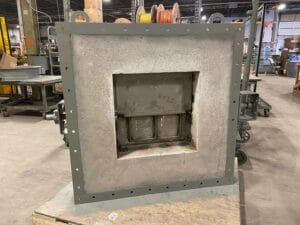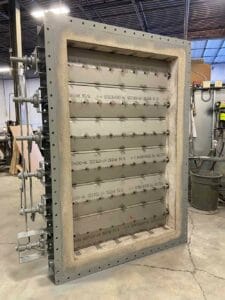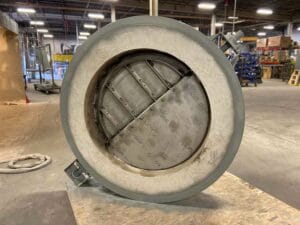What is a refractory damper?
December 21, 2022A refractory damper is a refractory lined damper that is specifically designed, engineered, and fabricated to isolate and control high temperature process gas while reducing heat loss to its ambient environment. Refractory lining is used for high temperature dampers when steel alone won’t suffice for high temperature excursions.
Most dampers can be made with refractory lining; including but not limited to refractory butterfly dampers, refractory diverter dampers, and refractory louver dampers.
Things to consider when building a refractory damper
- Temperature: You’ll want to consider not only the average operating temperature, but the max temperature excursions as well. If excursions are exceeding 1600F, then a refractory damper should be considered not only for longevity of the damper body, but for safety as well.
- Side note: It’s important to assure that the method of temperature tracking is accurate. Temperature probes can become inaccurate over time, so scheduled calibrations should be made a priority.
- Material: There are many factors regarding material types and thicknesses that need to be taken into consideration when building a high temperature damper. Some common questions asked when quoting a refractory damper are: Is this an acidic environment? What is the max pressure the refractory damper will see? Is the process gas particulate laden? What type of temperature excursions will the high temperature damper experience and how long will these excursions last?
- Common materials that are used for refractory dampers include but are not limited to RA 330 and RA 253. Although both materials can handle temperatures upward of 2000F and have supreme oxidation and corrosion resistance, the type of material best suited for the refractory damper will always depend on the details of environment.
- Refractory curing process:
- There are two main refractory curing methods when building a high temperature refractory damper.
- Cured prior to shipment: The process for curing the refractory damper prior to shipment involves baking the high temperature damper on a “bake schedule”, after the refractory has been poured and set. The advantage is that the damper will be ready to install and no further curing is necessary. The disadvantage to this is that the refractory can become extremely fragile and it is not uncommon for the refractory lining to crack during shipment. If cracking occurs, the refractory lining should be removed, repoured, and recured.
- Cured after the refractory damper is installed: This refractory curing process is similar to the method mentioned above, with one major exception; the refractory is cured through a simple “bake schedule” in-process, after the refractory damper is installed. Kelair finds this method most advantageous for end-users, as this curing process eliminates the possibility of the refractory cracking during shipment or installation. Instead, you are left with a cured, intact, effective refractory damper.
- There are two main refractory curing methods when building a high temperature refractory damper.
Want to learn more about Kelair refractory dampers?
Ready to get started on your refractory damper quote? Click here to contact us and we’ll be happy to help.




